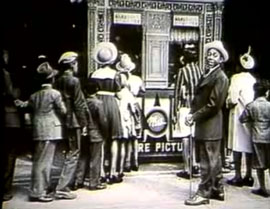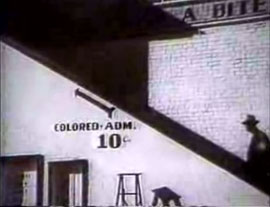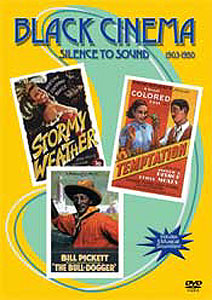 The video compilation Black Cinema: Silence to Sound 1903-1950 (2007) hasd as its main component a short documentary, Race movies: The Popular Art of The Black Renaissance (1985).
The video compilation Black Cinema: Silence to Sound 1903-1950 (2007) hasd as its main component a short documentary, Race movies: The Popular Art of The Black Renaissance (1985).
The documentary, narrated by Bill Grimmett, is too synoptic to have much to say to anyone already aware of some of the history of black cinema. But it's a nice introduction to the topic for viewers only beginning their journey through this rich heritage of "race films."
There is certainly some interesting visual material to support the narration. For instance, among the more unusual clips from the earliest period of cinema, we see an unfunny Keystone "comedy" Colored Villainy (1915), Uncle Tom's Cabin (1903), A Nigger in the Woodpile (1904), featuring blackfaced white actors in stereotyped situations of ineptitude, sycophantry, & thievery.
A period photo of the colored entrance of a cinema house, putting black folks in the balcony where they never come shoulder to shoulder with white folk, is an important reminder of how things once were, & that times have indeed changed.
 Yet it was segregation that gave rise to independent race films, so good can come even of bad things. Yet it was segregation that gave rise to independent race films, so good can come even of bad things.
With integration & a "single" multiracial audience, black independent filmmaking was rapidly put of of business by Hollywood. The loss of black ownership of cinematic images assuredly did not mean the content of mainstream cinema would be improved for black audiences.
The dvd release of this documentary comes with a hodgepodge of short films, including Ethel Waters in Bubbling Over (1934), Lena Horne in Boogie-Woogie Dream (1944), documentary The Negro in Entertainment (1950), a filmed radio program for black soldiers featuring Lena Horne among others, Jubilee: Strictly G.I. (1942), the only film performances of Leadbelly (1945), & a silent film comedy Spying the Spy (1918).
There's additionally a silent cartoon of dubious interest, a "home movies" silent version with intertitles of Ub Iwerks' Little Black Sambo (1935). Plus there are six "soundies" made for 1940s visual jukeboxes.
These delightful musical shorts feature Count Basie & his orchestra, with saxophonist Jimmy Rushing doing the vocal for Take Me Back, Baby (1941); Nat "King" Cole Trio with Ida James singing the Louis Jordan classic Is You Is or Is You Ain't (1944), barrelhouse pianist Ann Lynn Albritton with thrilling street dancers in Block Party Revels (1943), Maurice Rocco with dancer Mabel Lee in Beat Me, Daddy (1943); vocal group the Chanticleers performing the novelty tune Babbling Bess (1943), & the Four Ginger Snaps vocal group with the least thrilling of these numbers Keep Smiling (1943).
The soundies & other short subjects are for the most part much more thrilling than the minor documentary.
copyright © by Paghat the Ratgirl
|


 Yet it was segregation that gave rise to independent race films, so good can come even of bad things.
Yet it was segregation that gave rise to independent race films, so good can come even of bad things.